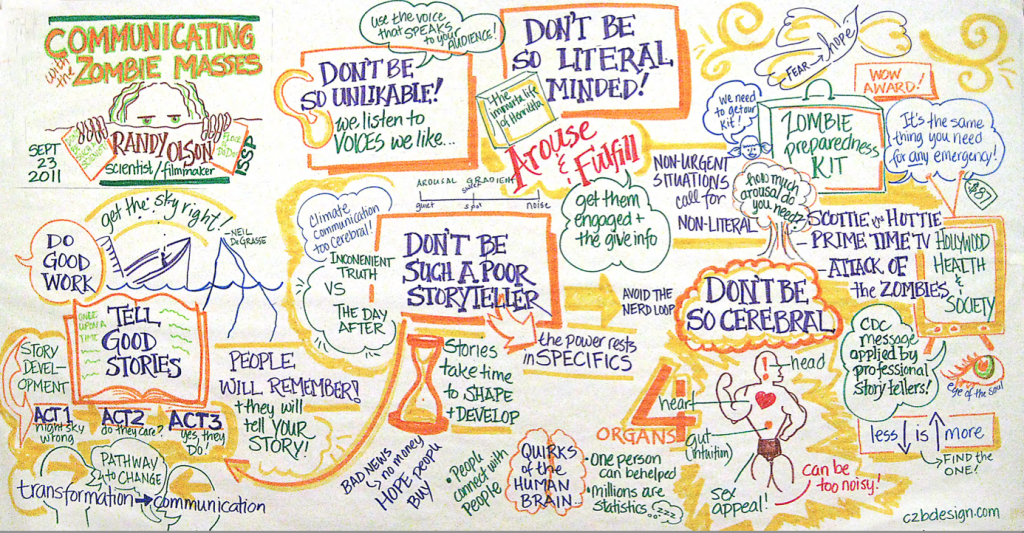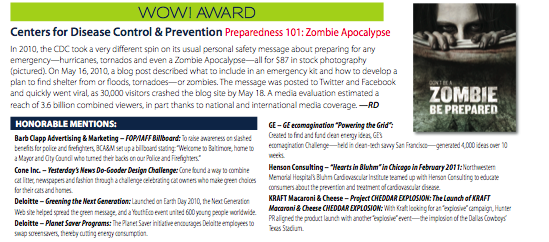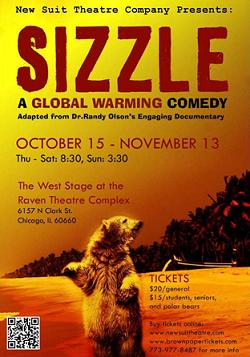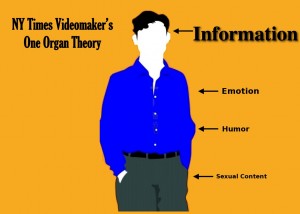#156) Read My Book Backwards, Please
September 29th, 2011
I’d like a Mulligan on the order of the chapters
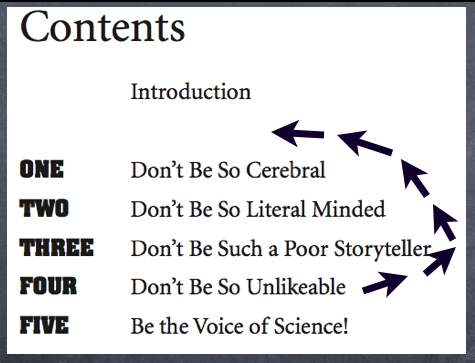
I’ve come to realize the logical flow of the four core chapters of my book, “Don’t Be Such a Scientist,” actually work best in reverse order.
mulligan
4, 3, 2, 1, BLAST OFF!
If you’re as lousy of a golfer as I am then you’re familiar with the age old tradition that allows you to hit your first drive into the woods, shout, “Mulligan!” to your partners, then start things over again. I’m beginning to think I’d like the same thing with the order of chapters in my book.
As I’ve given lots of talks on it, I’ve come to realize that the best way to put the contents of the book to work is to actually start with the last of the 4 core chapters first then work backwards.
START WITH LIKEABILITY
The fourth chapter is about likeability and unlikeability — or more specifically about finding the right common ground/messenger with your audience. I didn’t write this in the book, but what I say these days is, “It’s as simple as this — people listen to voices they like, they don’t listen to voices they don’t like.” Just like music. You can write beautiful lyrics, but if you pick a horrible singer to perform it, no one will ever even get to the content of your lyrics. As Malcolm Gladwell made clear in his brilliant book, “Blink”, it all happens very, very quickly. People hate the voice and disconnect in just a few seconds. And everything is over with.
How do you create a likeable voice? That leads to the third chapter which is about storytelling. More than 85% of the world’s population get their daily values and norms from the stories they learn from their religions. It’s still the most powerful means of mass communication. People love stories, so tell a good story (with the right voice) and they will listen.
How do you tell a good story? You need to be less literal minded, which is the contents of the second chapter.
And how do you become less literal minded? You have to come down out of your head to use emotion and humor. Which is the contents of the first chapter.
All of which is a more practical and useful flow of the information than the way in which is it laid out. So if you plan to use the book in a class or workshop, I strongly recommend you give thought to this.
And by the way, all of this falls under the subject of “story development” — as in developing the story of the book. I had about 30 years of incubation behind the writing of the book, going all the way back to 1974 when I first started working with scientists as a college dropout and marveling at the way they talk and think. And yet, clearly that still wasn’t enough time to get the story exactly right.
I don’t have any regrets on anything in the book, but if I were to write it again today I’d put those four core chapters in this reverse order. It just has taken me a couple of years of speaking to realize this.
Bottom Line: It takes A LOT of time to tell a good story with the most logical sequence of events. I’ve just figured this one out, two years after publication.
#155) My Talk on a Piece of Paper (Visually Recorded)
September 27th, 2011
The VERY talented Claire Bronson of c2bDesign “visually recorded” my talk last week in Portland to the International Society of Sustainability Professionals. You can click on the photo for a full-res version of the drawing.
This is my brain on paper. While I gave my talk last Friday in Portland at the International Society of Sustainability Professionals, they had Claire Bronson off to the side performing live, drawing/writing. This is the “visual recording” of everything I said. You can see more of her excellent work here.
mind drawing
CONCISION
This is so cool I’m not going to muck it up with a bunch of my drivel. The thing speaks for itself!
#154) When Good Things Happen to Good People: Zombie Preparedness and Dot Earth
September 16th, 2011
I cannot say enough good things about the CDC’s Zombie Preparedness Campaign, and now it’s won a “WOW!” Award for P.R. And equally deserving is Andy Revkin of the big award he won for his Dot Earth blog. These are things I love.
There could be no more appropriately named award for the CDC’s Zombie Disaster Preparedness campaign than the “WOW!” award. Indeed. Wow!
zombies eat brains
ZOMBIES KICK DISASTER ASS
I’m about raved-out on this topic. I don’t know how much higher of a thumbs up I could give it. I was at CDC again this week doing another communications workshop (my 4th in the past year — they are such a great group of folks there). The same day, Dave Daigle and his colleagues who co-created the amazing Zombie Preparedness campaign were in NYC for the Platinum P.R. Awards where they won 2 of the 5 categories for which they were nominated.
I already gave the detailed account of why I feel this is a textbook case study in how NON-LITERAL communication can create revolutionary impacts. The people involved with communicating about climate change absolutely must take heed. The subject of “disaster preparedness” had become one of those topics at CDC where the prevailing attitude said, “you just can’t get people interested in disaster preparedness when there’s no disaster.”
These folks proved that sort of malaise to be 100% incorrect. So for all the climate clods who whine that, “you just can’t get people interested in a disaster that’s 50 years away,” I say, WRONG, WRONG, WRONG.
You just need to be creative. Which is something that hasn’t happened yet in the climate community, due to the staid, cautious, narrow, stiffling, politically correct attitudes that prevail at the top. No wonder a billion bucks was squandered over the past decade.
DOT EARTH GETS DESERVED RECOGNITION
Also in the winners circle this week is Andy Revkin with his Dot Earth blog at the NY Times. He became the first person to win for a second time the Communications Award given jointly by NAS, NAE and the Institute of Medicine.
He is simply the best voice out there on the subject of climate. If there’s anyone at all close to the genuine idea of “fair and balanced,” surely it is he. And he has the battle scars to prove it — routinely taking beatings in equal measures from the far right and the far left.
But most importantly, he is a true conversation leader with his blog — using it more often than not as a forum for his readers to talk amongst themselves.
Congratulations, Andy. So truly deserved.
#154) The Climate Community is far behind Public Health when it comes to Communication
September 9th, 2011
There are so many examples. Here’s one which matches the basic recipe of my book — create a likeable voice by telling effective stories, producing a less literal mode of communication that ends up being effective because it is less cerebral. It’s really not that hard — all you have to do is just break the Nerd Loop.
nerd loop
Television shows like Gray’s Anatomy, Private Practice, and even Sesame Street end up being very likeable tellers of stories that, thanks in part to the Hollywood, Health and Society project end up including accurate public health information from the Centers for Disease Control. The result of this is a form of communication that is non-literal (i.e. NOT bonking people over the head with the facts) and less cerebral, resulting in more effective broad communication. Now if only the massively cerebral climate community can figure out such things.
nerd loop
BREAKING THE NERD LOOP
Earlier this year Dave Roberts of Grist interviewed Sandra de Castro Buffington about Hollywood, Health and Society — a project that has existed for about a decade in the Norman Lear Center for Entertainment Studies at the U.S.C. Annenberg School of Communication. I’ve gotten to know Sandra and the project over the past year by working with her conducting communications workshops at the Centers for Disease Control in Atlanta.
The HHS project embodies pretty much ALL of the basic principles of my book — it creates a likeable voice (ch. 4), through the effective telling of stories (ch. 3), which is a less literal means of communication (ch. 2) that is less cerebral and thus reaches the mass audience (ch. 1). And just to put the icing on the cake, each year they hand out their Sentinel Awards to the television shows that have done the most effective job.
Why isn’t the climate community engaged in this? Maybe they are getting ready to conduct a poll to find out how many Americans would like to see a project in which a likeable climate voice is created. (this is a lot like the argument I got into once when I said that PBS doesn’t know how to produce comedy, and a guy replied, “Yeah, but I once saw a documentary ABOUT comedy on PBS”).
#153) Let’s Kickstart “Sizzle: The Play” in Chicago
September 6th, 2011
They’re young, they’re eager, and they’re very cool — who better to support in this crazy world???
COMING TO CHICAGO ON OCTOBER 15: SIZZLE THE PLAY!
sizzle
It’s been over a year in the making, but the time is now rapidly approaching for the opening of the stage version of my movie, “Sizzle: A Global Warming Comedy.” The New Suit Theater Company in Chicago is putting on the production. They could use YOUR help in their Kickstarter fundraising drive. I just gave them a substantial donation.
If you’re thinking, “How can I do something meaningful,” in the struggle to communicate global warming to the general public, this is a perfect opportunity. This is a VERY creative and “outside the system” effort they are putting together. It’s a group of college aged folks who want to engage in an important issue in a creative way.
So make a statement for originality by going to their KICKSTARTER PAGE BY CLICKING HERE and give ’em a few bucks. They’re on to something very cool.
#152) Q: What Do You Get When You Avoid the Lower Organs?
A: NY Times Videos
September 2nd, 2011
If you have a powerful brand, you can afford to make a video without sex, emotion and only the driest and most sparse allowance of humor.
HOW TO MAKE A NY TIMES VIDEO. Watch the videos on blogs of the NY Times and you’ll see a very specific style that has been crafted to capture the staid voice of the esteemed newspaper. You won’t find anything from below the belt, only the driest of humor, and pretty much of a taboo on reaching for heartstrings. Such is the recipe for keeping things classy and dignified. But also, sometimes not that exciting.
The once proud and mighty NY Times (which of course I still swear by) was forced a few years ago to enter the blogosphere to stay alive. Then to give a little juice to their blogs, they began producing videos. Which are great. Don’t get me wrong. But if you look at the style of the videos… well, it’s kinda funny. And also kinda telling.
Andy Revkin periodically has their sort of almost branded style of videos on his wonderful environmental blog, Dot Earth. Now here’s a great article yesterday about Gregor Hodgson’s Reef Check project getting a start in the Caribbean nation that probably most needs what they have to offer given the depleted fish resources of Haiti. (it’s an excellent article AND nice video).
very very
KEEP IT CEREBRAL, MATE
So they seem to have developed their own unique style of videos that emulate the staid voice of the long serving “All The News That’s Fit to Print” brand. The videos are deliberately slow, somewhat ambling at times, very descriptive, with a narrator who probably has electrodes attached to sensitive body parts to make sure that he doesn’t come down out of his head into the lower organs — I’m guessing they’d give him a small shock for any emotion, a huge jolt for anything approaching sexual content or broad comedy, but apparently there’s a bypass for small, dry bits of occasional humor.
It’s just funny. The exception that proves the rule of the 4 Organs Theory. If you have a powerful brand name (as they do) you can afford to be dry, borderline dull, and always taken seriously. For NY Times videos, the proper approach is to NOT come down out of your head into the lower organs.
